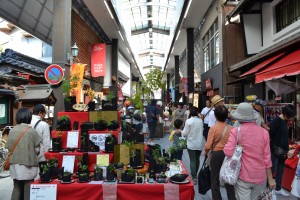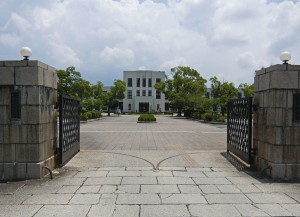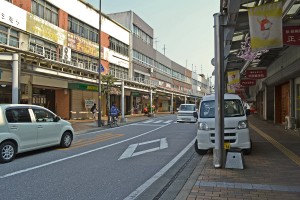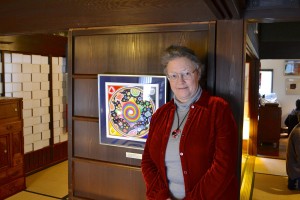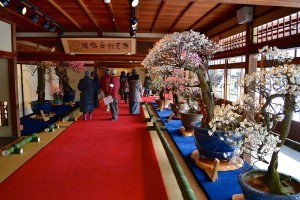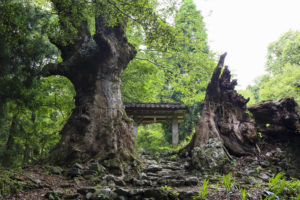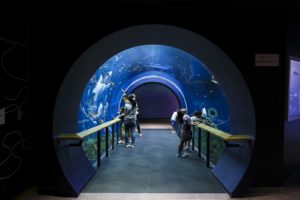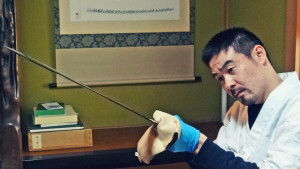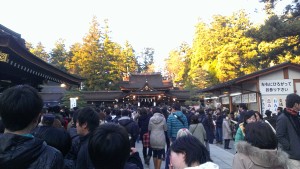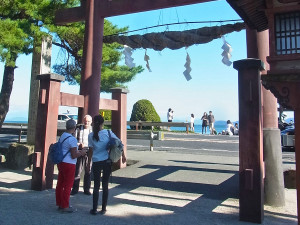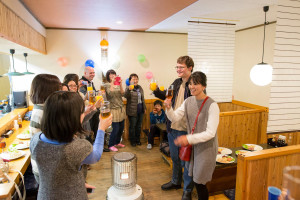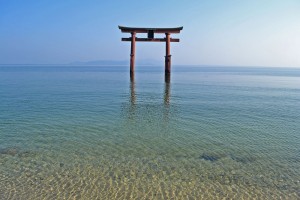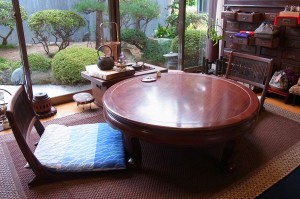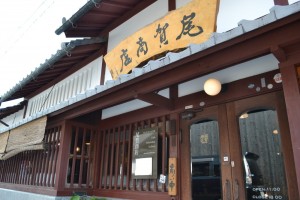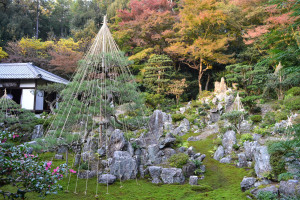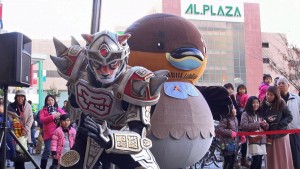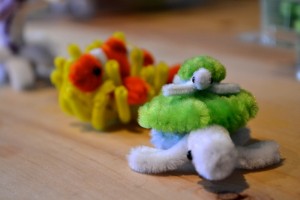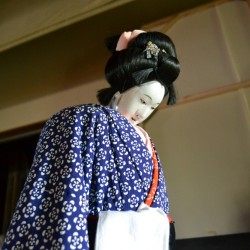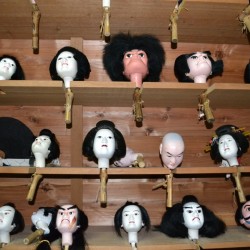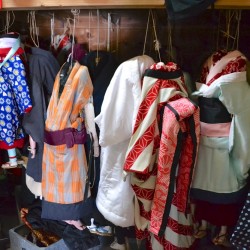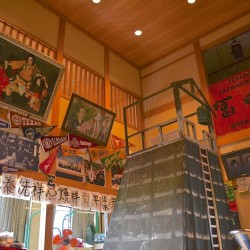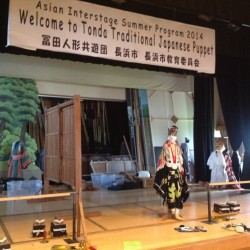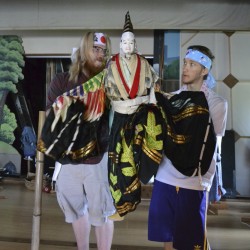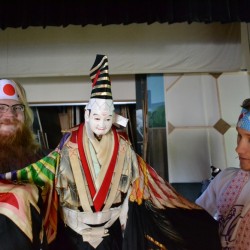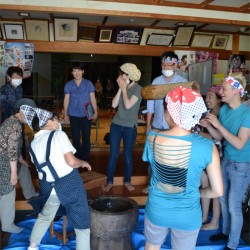Tonda Puppetry Troupe
Tonda Puppet Troupe (冨田人形共遊団 Tonda ningyō kyōyūdan) is a locally famous Nagahama area group that has been doing traditional bunraku performances and puppetry workshops for almost 200 years.
There is actually a decent English language Wikipedia entry about Tonda Puppetry, so you can learn more about the background over there, but a few highlights to give you some idea: Tonda Puppetry has been designated as an official cultural treasure, they still put on a few shows every year sometimes as workshops with local elementary children, they’ve performed overseas many times, and for over a decade they’ve been hosting an annual summer program for foreign college students.
The college exchange runs from June through July every year, giving international students a chance to study traditional Japanese culture while staying with local host families. Neither the program director and head of Tonda Puppetry, Abe Hidehiko, nor the host families are fluent in English, so it is a truly immersive language learning environment, which is one of the primary reasons students are drawn to the program.
At the end of July, the students are challenged with the task of performing a traditional bunraku puppet show in front of a local public audience. Over the course of their stay, most of their time is devoted to preparing for this final performance. 4 days a week are set aside for practice, but every Friday, Mr. Abe plans regional day-trip outings giving them a chance to explore other areas of Japanese culture.
We recently had a chance to stop by the puppet theater on one of their practice days to meet this year’s group and learn a little more about the program. Mr. Abe explained that he aims for around 10 – 12 students to participate each year, as 2 are needed for the play’s musical accompaniment (played on shamisen), two play narrator like roles, and the others are needed for puppets. One puppet requires 2 or 3 people for the full range of movements, and they can weigh up to 5 kilograms!
the Tonda Puppetry program offers a unique window into Japanese culture in addition to the immersive language learning.
This year’s group includes 8 members, 6 from various US univerities, and two from Italy by way of London. In the early years of the program it was sometimes difficult to find students, but now thanks to the program’s international recognition and help from alumni, they have a steady pool of applicants. Most join as part of a Japanese language program or related major, but arts and culture are often what attracted them to the language in the first place, and the Tonda Puppetry program offers a unique window into Japanese culture in addition to the immersive language learning. The language immersion is very real as there are no native/fluent staff to assist them locally for most of the stay, and if you’re familiar with Biwa-cho or northern Nagahama, then you know it’s a very traditional Japanese small-town, relatively isolated from any big cities or international communities. But despite what may seem to be a restrictive environment, during our chat they all had nothing but good things to say about their time here. The program keeps them busy most of the week anyways, and small-town Japan has offered plenty to see and do when they’ve had time to explore.
As a side note- this last bit struck a chord with me based on recent conversations I’ve had with local residents about launching Be Wa. When we explain the project, we often get a reaction of bewilderment about what could possibly draw foreigners or tourists to Shiga. But for new visitors, I think these less-travelled areas are often preferred or even sought out, especially when they need a break from the big cities, and Shiga has plenty of traditional small-town culture that is just a short train ride from the bigger tourist stops. For example, and on the topic of the Tonda Puppetry Troupe, Nagahama is one of the few places where all three forms of traditional Japanese theater are represented: Noh, Bunraku, and Kabuki. These 3 forms of theater represent the linear progression of traditional Japanese performing arts, and it is quite rare to find all 3 in the same place. We’ll probably cover the other two in future articles here, but kabuki is represented in the child-kabuki of Nagahama’s Hikiyama Festival, and Noh was practiced historically in the region and is now featured in local museums and sometimes performed for local events.
For anyone interested in this year’s summer performance, it will be held on Sunday, July 27th at 1:00 pm at the Nagahama Cultural Center. Tickets are 1,000 yen in advance, or 1,200 yen at the door (child admission is free). You can purchase advance tickets via the Nagahama Cultural Center at 0749-63-7400. More details here in Japanese.
冨田人形共友遊団は、200年もの長きにわたり伝統文芸である「文楽」を演じ継承しているとしてここ長浜において広く知られています。ここで紹介するまでもなく、Wikipediaに歴史背景などもっと詳しい情報がありますのでそちらを読んでみてください。本記事では、特に印象に残った話を紹介したいと思います。
冨田人形は民俗文化財として登録されています。毎年、数回の公演が開催され、そのうち地域の小学生への教育プログラムの一環として行われているものもあります。12年前から、毎年夏に外国人留学生を招き冨田人形サマープログラムが開かれており、それ以降、海外でも幾度となく公演が行われています。
このサマープログラムでは、毎年6月の終わりから7月にかけて、海外からの留学生がホームステイをしながら日本の伝統文化に触れるという機会が提供されています。冨田人形共遊団の団長でこのプログラムのディレクターでもある阿部秀彦さん始めホストファミリーのみなさんは、流暢な英語を話すわけでもありません。しかし、こういった環境が逆に日本語をしっかりと身につけるのに最適だとして、外国人留学生を惹きつける一番の理由になっています。
7月の終わり、地元の観客を前に留学生たちは最終公演に挑戦します。それまで、滞在中の大部分はその公演のための練習に費やされています。1週間5日のうち4日間は練習ですが、残りの1日、毎週金曜日は阿部さんに日帰り旅行に連れ出してもらえるので、この地域以外でも日本の伝統文化を学ぶ良い機会となっています。
練習日のある日、私たちはここを訪れました。今年の留学生たちに会って話を聞くことでプログラムについても詳しく知る事が出来ました。阿部さんによると、毎年10名から12名の留学生を招くことを目標としているとのことですが、それには理由があります。2名は楽器演奏(三味線)、2名はナレーター(浄瑠璃)、そして残りは人形を操るのに必要な人数となります。一体の人形を自在に操作するためには、一体につき2、3名が担当するとのこと。なんと、一体5キロ(!)もの重さがある人形もあるとのことです。
日本語の習得だけではなく、日本文化に触れる「入口」を提供しているといった事が人気の理由
今年のメンバーは8名。アメリカの各地の大学から6名、そしてロンドンに留学しているイタリア人学生の2名です。プログラムが始まった最初の頃は、留学生集めが容易ではなかったのですが、最近は国際的にも知られるようになってきた事、又、プログラムの修了生たちの宣伝もあり、毎年安定した数の応募者があるようです。大学で日本語やその他日本に関連することを勉強している学生が多いのですが、そもそも日本語を専攻しようとしたきっかけで多いのは日本の芸術や文化への興味だという事です。ですので、このプログラムが日本語の習得だけではなく、日本文化に触れる「入口」を提供しているといった事が人気の理由でしょう。プログラム期間中、留学生をサポートしている地域の人の中にネイティブ外国人やバイリンガル日本人はいませんが、逆に日本語をマスターするには本当に良い環境です。この冨田人形がある旧びわ町もしくは長浜市北部がどんなところか知っている人は、ここが大都市や国際的な街から離れたところにある典型的な日本の田舎町だという事をご存じですね。しかし、どんなにここが若者にとって制限のあるところに見えようとも、彼らの口からは全く不満などは出ず、それより非常に楽しんでいるという声が殆どでした。まあ、どちらにしても、週の殆どはスケジュールで埋まっていますし、練習の合間にもちょっと出かければ何かしら楽しいことを見たり経験したりできるとのことですので、この環境こそが逆に彼らが退屈に思う暇を与えないのでしょう。
ちなみに、ここでちょっと思い出したこと。このBeWaで私たちが滋賀を海外へ紹介していることを人に話す機会があるのですが、この滋賀に外国人を魅了する要素があるとは思わなかったという反応を示す人が多いです。しかし、アメリカ人である私から見ると、こういった観光地化されていない場所のほうが、外国人観光客には好まれる傾向にある思います。特に都会の喧騒から脱出したい人たちにとって、主要観光地からちょっと電車に乗るだけでこういった伝統的が息づく日本の田舎を訪れることは魅力です。例えば、ここ長浜には、能、今回紹介した冨田人形の文楽、そして歌舞伎と、3つの日本の古典芸能が継承されています。能から文楽、文楽から歌舞伎とは、日本の舞台芸術が進化していった形でもあり、これら3つの古典芸能が一つの地域で全て見られるのも全国では珍しいようです。この地域のお祭りである曳山祭りの子供歌舞伎、博物館をベースに時々公演も行われている能についてもまた機会あればご紹介することとしましょう。
冨田人形の夏の公演は7月27日(日)午後1時から、長浜市の長浜文化芸術会館にて行われます。チケットは前売りで1000円、当日は1200円です(子供無料)。前売りは長浜文化センター(0749-63-7400)で販売中。詳細は日本語サイトから。

